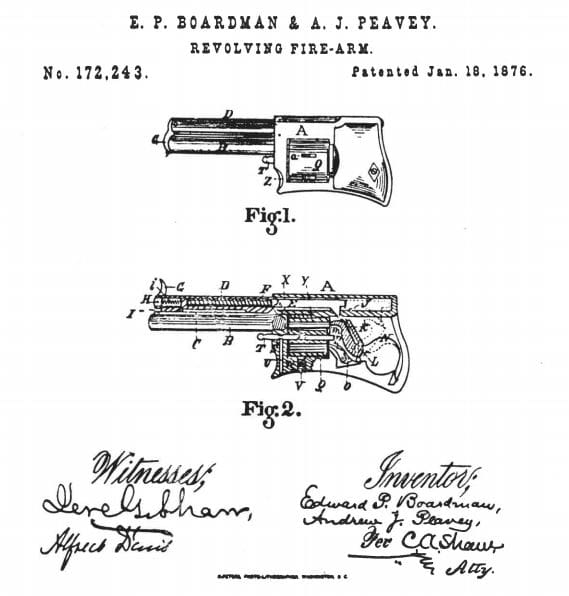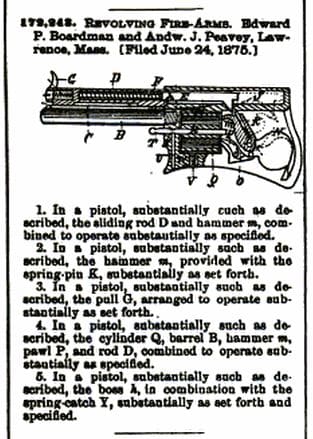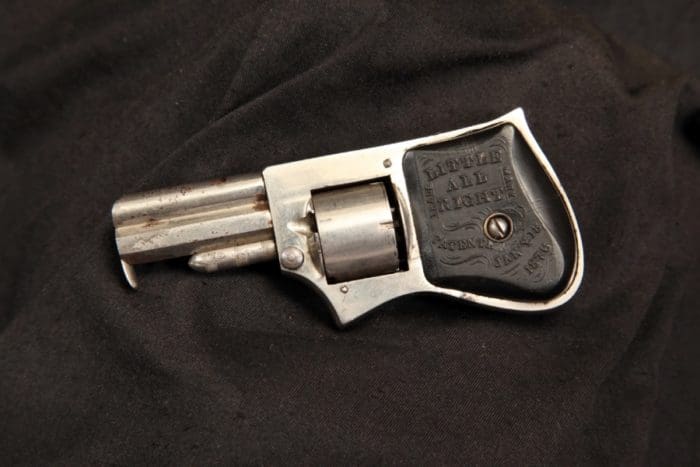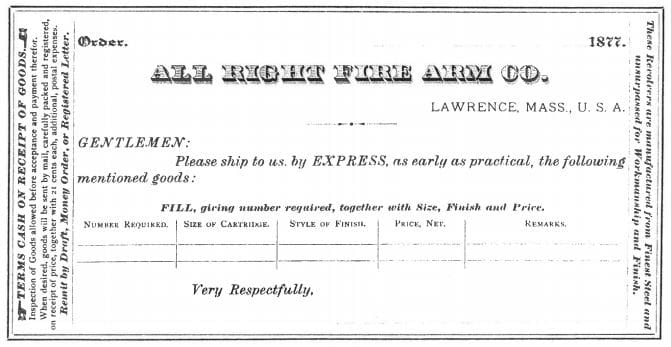Easy-to-conceal palm pistols were all the rage during the last quarter of the 19th century. Numerous companies produced countless variations of very similar designs.
One design was, however, quite different from the rest. Enter the “Little All Right” by the Wright Arms Co. of Lawrence, Massachusetts. Patented in 1876 by Edward Boardman and Andrew Peavey, their unusual pistol was little, all right! (Sorry for the bad gun pun.)

Designed to fire five rounds of .22 Short ammo, the gun is easy to conceal. It weighs a whopping four ounces and is five inches in length when equipped with the standard 1 3/4-inch barrel. A longer, 2 3/8-inch barrel was also available, but is rarely seen.
Because of its diminutive size, the gun must be grasped by wrapping your hand around the entirety of the arm. This means that part(s) of your hand will be covering up the gap between the cylinder and the barrel. While the likelihood of escaping gases is bound to be minimal given the caliber, I imagine it still would not be pleasant to come into direct contact with the fleshy part of your hand.
The trigger folds up – not down – when you’re ready to fire. It protrudes from the top of the frame above the barrel and is actuated by a spring. When not in use, the trigger folds down and covers the barrel, preventing any debris from entering.
Double-action operation reveals a trigger pull that is long and heavy, so much so that it makes today’s so-called “New York trigger” look like child’s play. You really have to want to pull the trigger in order to fire this pistol!

To reload, a button on the side of the frame is pushed, the center pin is removed, and then used to extract the spent casings. Load five more shots into the cylinder and then reverse the process to complete the loading procedure.
The hard rubber grip panels are actually really cool. Molded into them is the make and model, patent info, and manufacturer’s location. Because the material is brittle and prone to breaking, it’s not uncommon to see examples with cracked or replaced panels.

The exact number produced is unknown; estimates range from a few hundred to possibly one thousand, at most. Unsurprisingly, the design did not catch on. Other palm pistols were readily available that were easier to shoot, easier to reload, and were available in larger calibers.

Business records from Lawrence, MA, in 1877 note Boardman and Peavey as machinists. By 1879, there is no mention of their business. Much like the gun they made, their impact on the firearms industry was equally small.
Logan Metesh is a firearms historian and consultant who runs High Caliber History LLC. Click here for a free 3-page download with tips about caring for your antique and collectible firearms.





The cut of clothing and style of dress from this same time period made concealing weapons on your body easy. I never saw the need or practicality of these uber dwarf pistols. Anything smaller than a S&W number 1 or a Remington double derringer is just……well, ludicrous.
I have one. Love it.
Are you missing the tip of an index finger??
Just curious.
Yea. Bummer.
How’d you guess?
I figured you were a high school shop class teacher.
(I actually had a shop class teacher with the Rham ‘Tiny Dancer’ Emmanuel missing piece of finger treatment…)
.22 short… Dare I say a stern right hook would pack more of a punch.
On the plus side, you won’t need ear protection. Unless you are the one being shot in the ear.
That’s an interesting firearm. If only it came in .45 acp, oh well life goes on.
If it was in 6.5 CM it would be the ultimate weapon
Yikes!
I’ve been burned by light .38 spa by having a finger too far forward. Not pleasant!
Heh heh, I ran out of matches and tried to light a cigarette with the muzzle flash from a .44, friends said it wouldn’t work, it didn’t. Kerpow and I had pieces of cigarette and stinging fingers
Damn! You should’ve gotten that one on video…
Was that moment preceded by “here, hold my beer”?
Yikes! Ouch!
Knowing what I know now, I would not take that Bet.
The NAA mini-mags, most all styles would fit this category? Adds new meaning to “palm burn”.
Except that the naa’s don’t place your fingers near the muzzle as a normal grip and operation of the weapon. The naa weapons function more like a S&W tip up from the old days. Single action with a hammer and trigger that don’t require firing near or between body parts.
The NAA Mini .22 Magnum I had years ago was their older design where you pull the cylinder pin and remove the cylinder to load.
It was actually pretty accurate but required a lot of care when shooting it. I eventually got rid of it because I felt pretty awkward when shooting it and that made me nervous.
I wasn’t going to bring this up, as I thought it was obvious, but take a look at the actual design of this gun. . .
Your index finger is NEVER near the muzzle when the gun actually fires; The upper slotted ‘barrel’ is just a housing for the trigger rod and its spring, and as this mechanism has to be fully compressed to operate the self-cocking (not ‘double action’) internal hammer, it is about two inches back from the muzzle, and above it, when the gun fires.
The patent drawing also indicates a ‘rebound’ mechanism, so that the hammer is raised slightly off of the cartridge rims; The gun cannot fire until the trigger is fully compressed through overtravel, and the hammer notch slips off of the sear. After firing, the hammer returns to its rest position when the trigger is released, just short of the cartridge rims.
The cartridges that this gun fires are .22 Short BPs, loaded with about 4 grains of black powder; Their pressure is low, their flash almost nonexistent, and a lot of the energy available was dissipated in smoke and heat–not propulsion.
All of that said, this was NOT a ‘safe’ gun to be shot with in 1876; There were no antibiotics, surgery rudimentary, antiseptic practices ignored (they called the outcome ‘blood poisoning,’ and it was virtually uniformly fatal), and people died from infected mosquito bites. The little 29-grain bullets were greased on the inside, and created a filthy wound that rapidly became infected.
Even more so than today, people were VERY reluctant to get shot with anything, no matter how small, because of the knowledge that even a tiny little bullet would most likely kill them, eventually. However, shooting your finger off with this particular gun isn’t very likely, and any cylinder-gap gas that escapes isn’t likely to do much harm, either.
This little fella laughs at the idea of gun safety.
“What’s the worst that could happen?”
https://www.youtube.com/watch?v=d0ZnlsLAaiI
Why comment when I can get Ian to do it for me?
Comments are closed.